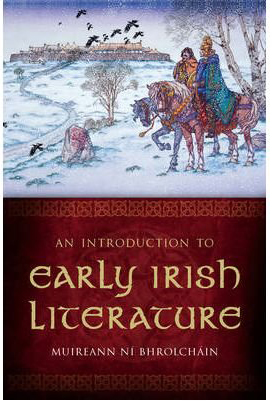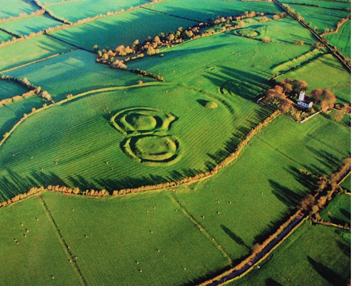A tribute to Dr. Muireann Ní Bhrolcháin, (1955 - 2015), of NUIM Department of Early Irish (Sean-Ghaeilge), whose leadership during the Save Tara Campaign to preserve the Hill of Tara environs inspired an international following and was the first campaign this collective contributed to, from 2006.
Note: Dr Ní Bhrolcháin's bibliography is available, with external links, on Wikipedia
i - Review:
An Introduction to Early Irish Literature, 2009, by Muireann Ní Bhrolcháin
ii - Obituary:
The Irish Times
 An Introduction to Early Irish Literature An Introduction to Early Irish Literature
by Muireann Ní Bhrolcháin,
Four Courts Press, Dublin, 2009.
ISBN 978-1-84682-176-9
Encyclopaedic Study
Reviewed by Maireid Sullivan
Published in Tinteán, the quarterly journal of the Australian Irish Heritage Network, issue No. 15, March 2011
In An Introduction to Early Irish Literature, medievalist Dr. Muireann Ní Bhrolchain shared her extensive command of Irish history, and includes a guide to what has been written on the subject by other scholars, with specific focus on the Old and Middle Irish periods, 600--1200. This examination of Ireland’s rich written heritage will appeal to readers seeking a single condensed resource on Irish stories.
The merging of the best of Old Irish and Early Christian spiritual traditions, often fondly referred to as Celtic Christianity, goes back to the 6th century. The Lament of Colm Cille (597) shows that the Irish language and tradition was being interpreted and used in a Christian context. International politics led to the demise of Irish native institutions when Henry II introduced Church politics along with major diocesan restructuring and reforms to Ireland in the 12th century. Until that time, Oral traditions continued in native institutions, alongside Irish secular studies in Church schools.
Sagas and poetry, ‘the substance of literature’, the main focus of this book, typically contain both prose and poetry, and combinations thereof. From ancient times, information on saga literature was passed down orally, through story, song, poetry and prose, until they were transcribed during the rise of the Bardic schools, when scholars of the oral tradition, in Irish history, law, and poetry, began to embrace Latin. Later generations of clerically educated authors continued to celebrate their ‘pagan’ (i.e., pre-Christian) oral tradition, even while holding high ecclesiastical offices and teaching positions at church schools.
While a break is found in the written record during the 13th century, poetry continued to flourish, probably due to the poets' training remaining independent of the church, as an educational system administered by the poets themselves.
The scope of this work is dazzling, as the following short digest of the topics studied reveals:
- Stories and storytelling; Druids, Poets and Bards;
- The arrival of Christianity;
- Oral Tradition, Ogham and Written Literature;
- The location and nature of the Otherworld;
- Voyages - especially the Brendan Voyage;
- Vision Tales;
- Kings and Sovereignty Goddesses;
- Madness in Early Irish Literature;
- The Hero and his typical trajectory;
- Poets and poetry and the prosimetrum.
Ní Bhrolchain continually reminds us of the tight control over the manuscripts exercised by monks. ‘Only learned classes of Fili (poets) and monks needed to learn to read and write.’ She argues that from the 8th century, the poets were set apart from the oral ‘bards’ by their literacy. Old Irish texts became the official authority on matters of grammar, versification, genealogy and history, and were modeled on the Latin curriculum of the church schools. Up until the 13th century, most native scholars, whether poet, expert in Irish traditional history (senchae), or judge of Brehon Law, have been identified as clerics or Christian teachers, possibly with a vested interest in documenting contemporary history of Christianity at the expense of ‘pagan’ elements in Irish culture. However, from the late 10th to the 12th centuries, the annals also record the works of learned court poets, some of whose verses in praise of Irish kings still survive.
Although the writers of the tradition were Christianized, Ní Bhrolchain contends that they were nonetheless steeped in traditional Gaelic world-view of the Otherworld. I would speculate that we have an excellent historical clue to the basis for this world-view in the Early Christian British argument over Free Will versus Original Sin: St. Augustine and his followers condemned the legendary British monk Pelagius (354-420) for rejecting the doctrine of Original Sin, and accused him of reviving the ‘Natural Philosophy of the Druids’ which is, essentially, that when the will is free there is no sin, and that we have the power to exercise choice in any moment. Pelagius wrote about ‘The ability. The will. The act.’ He believed in the pristine nature of humanity and that Adam’s fall had no impact on the created order. Suffice it to say, Pelagius was declared a heretic, and thrice excommunicated by the Church. Many writers since have returned to these ‘Pelagian’ arguments.
Eminent Irish historian Dr. Ní Bhrolchain has shone a bright light on a dark period of Irish history. This chronicling of Irish history makes a fine addition to the resurgence of interest in the unique spirit and character of ‘Irishness’, which is continuing to grow, even while the country has lost its sovereignty, once again. |
Obituary: The Irish Times
Back to top
Academic, inspiring teacher and defender of Tara
Muireann Ní Bhrolcháin: May 15, 1955 - April 14, 2015
The Irish Times, Saturday May 16, 2015

The academic, political activist and Tara campaigner Dr Muireann Ní Bhrolcháin, who has died aged 59, campaigned strongly for social justice issues through the Labour Party, working closely with Emmet Stagg, Michael D Higgins, while he was minister for arts, heritage and the Gaeltacht, and on Maynooth Community Council.
“Her research interests were in women in early literature and history and genealogy but her very particular passion was for teaching, where she enthralled and challenged her students with her unique energy, knowledge and humour,” said her colleague Dr Mary Leenane of NUI Maynooth (NUIM).
She was raised in Salthill, Galway, one of three daughters of Cillian Ó Brolcháin, professor of physics at UCG, and Mairéad Coughlan, from Macroom, Co Cork, a domestic science teacher before her marriage. She attended Scoil Fhursa, Nile Lodge primary school and Salerno Secondary School, Salthill, one of only three schools of the Jesus and Mary Sisters in Ireland. At school she was very involved in musical productions, often playing a leading role.
Lore of women
She was active in musical and theatre productions in the Taibhdhearc in Galway and was an accomplished singer. She met her husband, Jim Cunningham, through the Galway theatre scene, and they had two daughters. They later separated.
She began lecturing part-time in modern Irish at NUIM in 1980, then became a full-time lecturer in the department of early Irish.
She promoted Irish language and culture, eventually becoming associate dean and senior lecturer in the school of Celtic studies. She was instrumental in the establishment of the Centre for Irish Cultural Heritage there; she was also a member of the university’s governing authority.
Widely published on many aspects of early Irish literature and culture, including the recent Introduction to Irish Literature (2009), Ní Bhrolcháin was also an award-winning author of adolescent fiction in Irish and a scriptwriter for TG4’s Ros na Rún.
Drawn to politics from a young age, she was deeply involved in Labour campaigns during both the divorce referendums (1986 and 1995). She served on Maynooth Community Council for 30 years, filling many roles.
Tara campaign
In May 2005, she helped to get 350 academics from all over the world to sign a statement calling on the Irish government not to proceed with the route.
Dr Ní Bhrolcháin is survived by her long-term partner, Don Foley, whom she met in 1986, by her daughters Eithne and Rachel Cunningham and by her sisters Clíona and Deirbhile.
Note:
Dr Ní Bhrolcháin's bibliography is available, with external links, on Wikipedia |
Back to top
|

